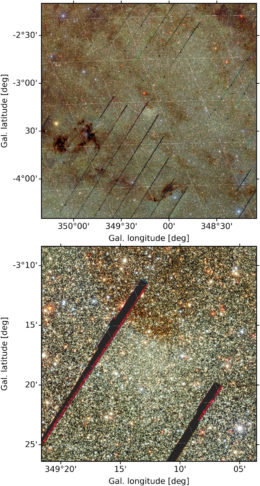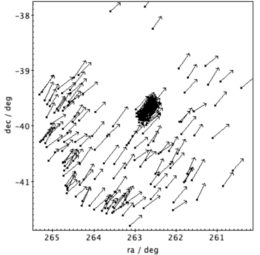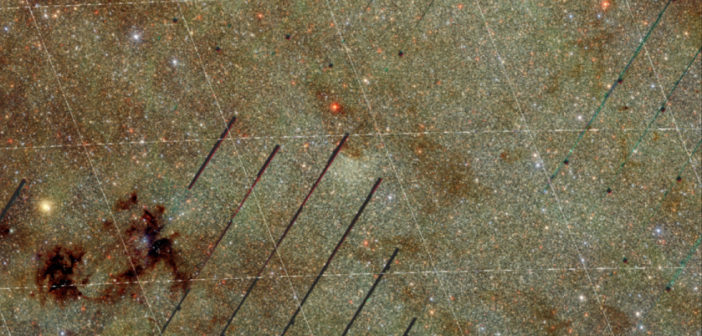You might think that we’d already discovered all the large clusters of stars orbiting our galaxy. Surprisingly, there are still detections to be made — such as the recently discovered cluster FSR 1758. But is this large group of stars an enormous globular cluster? Or a newly detected dwarf galaxy?
A New Cluster

A wide-field view (2.5° x 2.5°; top) and a zoomed-in view (18’ x 18’; bottom) centered on FSR 1758 from the DECaPS survey. [Barbá et al. 2019]
Based on the limited observations we initially had of FSR 1758 — and because clusters residing in the galactic bulge are typically expected to be of low mass — it was assumed that this object was a globular cluster: a spherical collection of stars that all formed around the same time from the same cloud and are bound by their mutual gravity.
But could the difficulty peering into the galactic bulge mean that we’re missing important details? Another theory posits that the part of FSR 1758 we’re seeing is instead the nucleus of a faint dwarf galaxy orbiting the Milky Way; we simply can’t see the fainter outer reaches of the galaxy.
So which is it: globular cluster or dwarf galaxy? A team of scientists led by Rodolfo Barbá (University of La Serena, Chile) have gathered observations to find out.
Revealing Details
Barbá and collaborators use three different sets of observations to explore FSR 1758: optical data from Gaia’s DR2 and the DECam Plane Survey, and near-infrared data from the VISTA Variables in the Via Lactea Extended Survey. From these data, the authors determine the cluster’s position and distance, as well as its size, metallicity, absolute magnitude, and proper motion.

Spatial distribution of stars that have common proper motion, suggesting that they belong to FSR 2758. Beyond the visible custer of stars at the center of the group, FSR 1758 appears to have a possible larger extended structure, suggesting it may be the nucleus of a dwarf galaxy. [Barbá et al. 2019]
Lastly, the authors find additional asymmetrically distributed stars further out in the field with motions and colors indicating that they also belong to FSR 1758. These suggest that the cluster may be more extended than originally thought and might have tidal tails. These signs support a picture in which FSR 1758 is the nucleus of a dwarf galaxy — which the authors tentatively name the Scorpius dwarf galaxy.
Though we still don’t have a definitive answer about FSR 1758’s nature, we can hope that future spectral data for its stars will settle the debate. And in the meantime, it’s good to be reminded that our galaxy is still hiding some surprising discoveries.
Citation
“A Sequoia in the Garden: FSR 1758—Dwarf Galaxy or Giant Globular Cluster?,” Rodolfo H. Barbá et al 2019 ApJL 870 L24. doi:10.3847/2041-8213/aaf811


7 Comments
Pingback: AAS Nova – New
Pingback: Daily Study Log (2019-02-13) | Study Astrophysics
Pingback: ¿De qué se trata FSR 1758? | Pablo Della Paolera
Pingback: Dwarf Galaxy or Giant Globular Cluster? - Worldika - New Platform For Explore World
Pingback: Dwarf Galaxy or Giant Globular Cluster? – AstroBrief
Pingback: Dwarf Galaxy or Giant Globular Cluster? - Astronomy News - Astronomy articles
Pingback: Dwarf Galaxy or Giant Globular Cluster? - Astronomy News - Astronomy articles